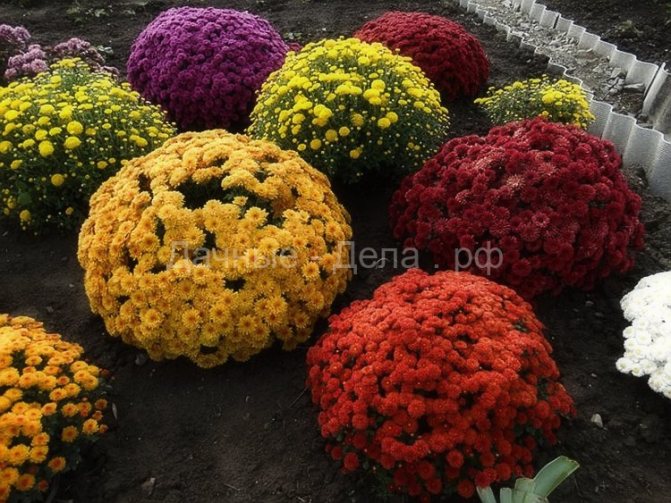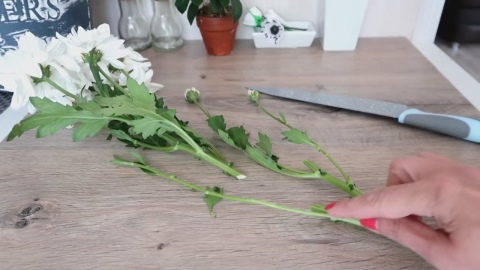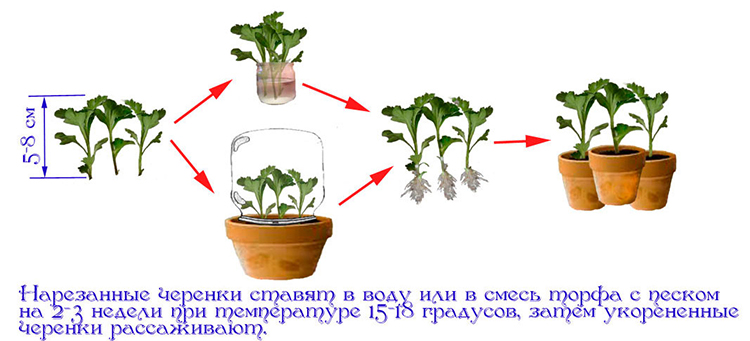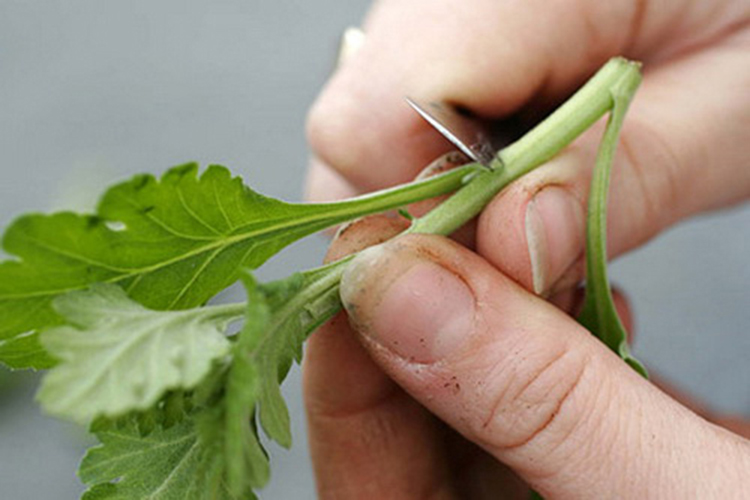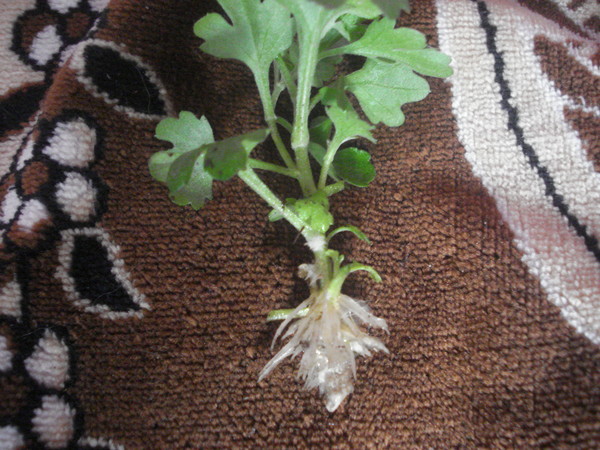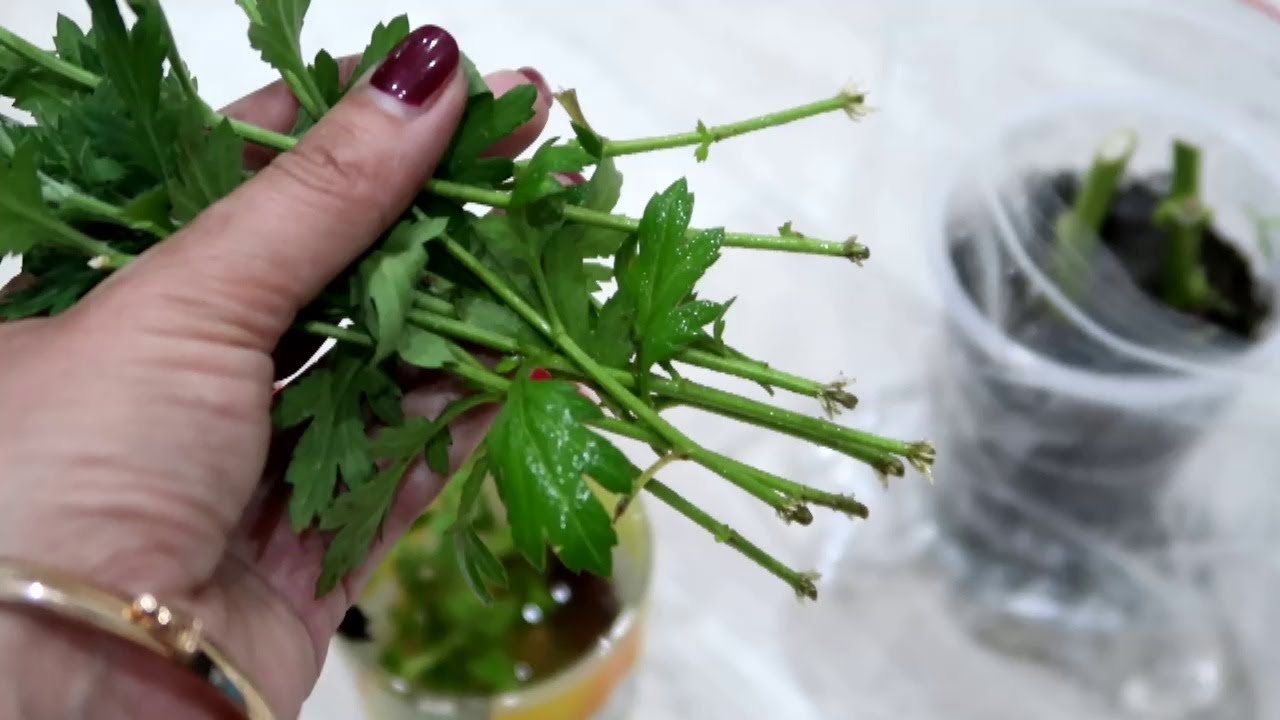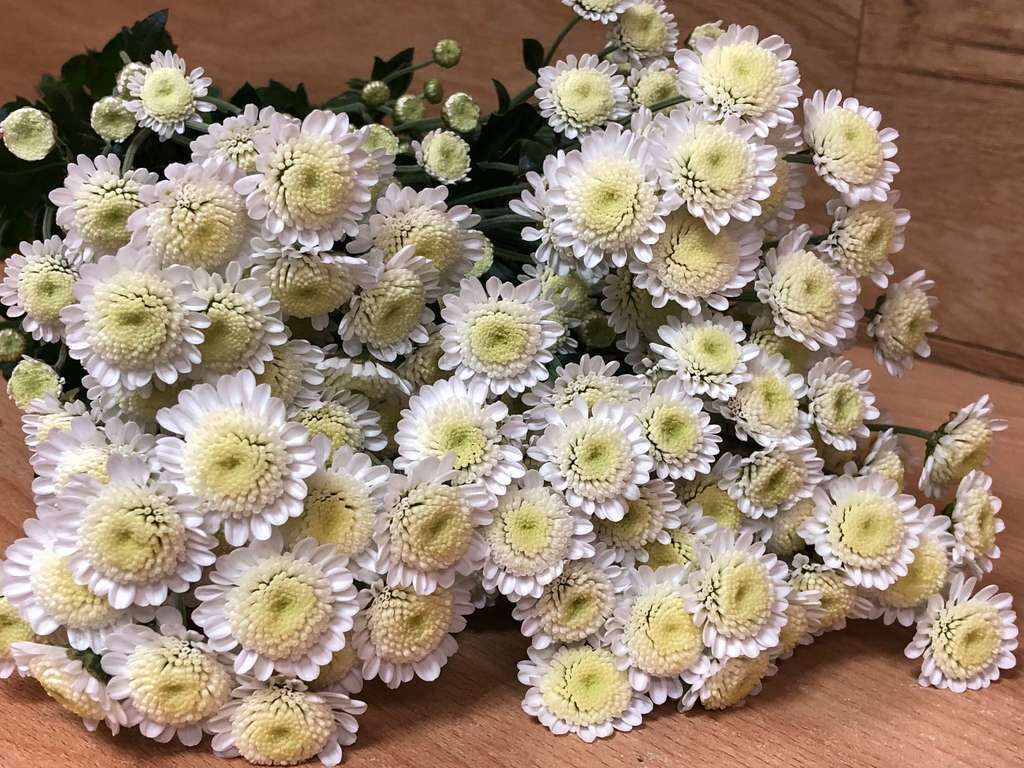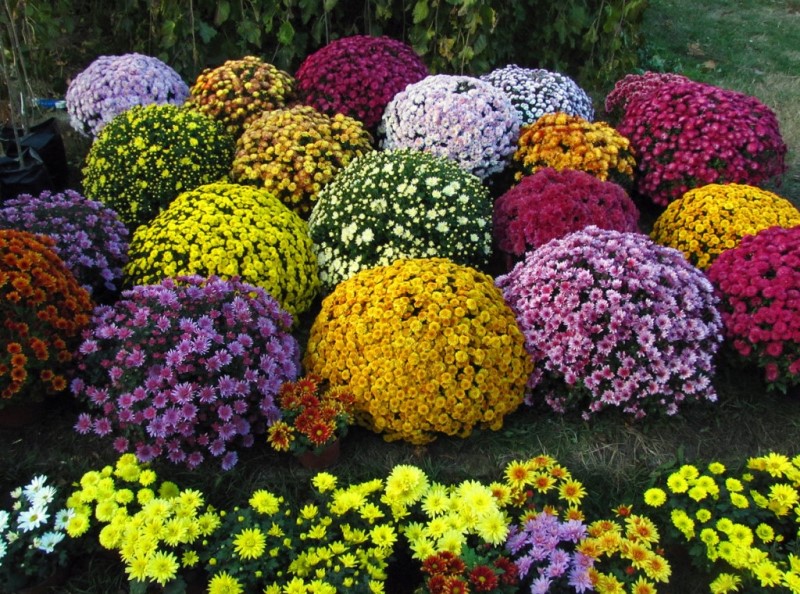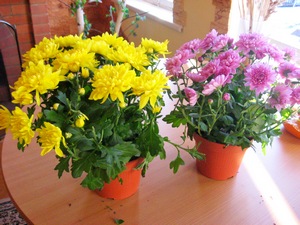Chrysanthemum cuttings in spring
The best time for grafting is spring. The period from March to April is for the early varieties of chrysanthemums, from April to May for the middle and late varieties. How to quickly grow chrysanthemums from cuttings for spring planting in the ground? This is not difficult.
When to cut a chrysanthemum
From the middle or the end of February, the bush is transferred to a warm room and watered abundantly. It is possible, but not necessary, to feed the plant with organic fertilizer. Ammonium nitrate gives good growth.
When young shoots appear - after about 8-12 days, they are allowed to grow up to 10-12 cm, and then they are cut to the full length.
How to prepare cuttings
The tops are broken off or cut off completely, leaving 2-5 leaves on the uterine hemp - this is enough to resume growth. On the cuttings themselves, in order to avoid their decay, the lower leaves are removed and the upper ones are shortened by 1/3 - they pinch, if there are side small buds on the shoot, they are also cut off, and then planted.
Planting the cuttings in the substrate
The soil for planting must be well moistened. The depth of the hole is no more than 2 cm, the distance between the cuttings is 5-6 cm, if three or four cuttings are planted in a container. You can plant one cuttings at a time in a small pot or plastic cup.
How to care for a cutting
If these are medium and late varieties and the weather is warm enough, the containers are taken outside, into fresh air, but placed under a canopy to protect them from rain and gusts of wind.
Watered sparingly and carefully, avoiding either drying out of the soil or excess water. 14-16 days after rooting, the cuttings can be transplanted to a permanent place.
Early varieties, when it is still cold enough in the yard, are covered with foil so that the boxes with cuttings are under the dome. The free space between the tops of the cuttings and the film is left at least 35 cm.
Water enough, periodically removing the film. The main sign of rooting is the growth and appearance of new leaves. After the appearance of 5-7 new sheets, pinching is done. The second time, the upper leaves are shortened when the lateral shoots reach a length of 9-10 cm.
For 7-10 days before planting, "film" cuttings must be hardened. To do this, they are opened and taken out onto the veranda or balcony, they can be placed near an open window without drafts, and it is better to cover them again at night. They are planted in the ground after the threat of frost has passed.
There is a way how to propagate chrysanthemum by cuttings without first germination and rooting in containers. This is another option for spring cuttings of chrysanthemums - directly into the ground.
It is made in late spring in mid - early May and June, that is, when the weather is warm. Cuttings are cut from overwintered bushes that have already given young shoots.
To do this, a new branch of chrysanthemum should grow by 14-15 cm. Cut it to half - about 7-8 cm. Plant immediately in a high bed, sprinkle with sand and water.
The top is covered with a film, the air gap between the top of the cutting and the film is at least 50 cm.If the weather is warm, then you do not need to cover it with polyethylene; if it is colder, then it is covered.
After 15-18 days after rooting, the seedlings can be transplanted to their permanent designated place.
Cutting by seasons
An important issue requiring a deliberate decision is the choice of the propagation season. Chrysanthemums reproduce well by cuttings in the fall, but some gardeners do it in the summer and spring. There are reasons for this, but it is better to choose a season based on the following criteria:
- variety of flowers;
- inflorescence size;
- number of stems.
Also, in each case, it is necessary to assess the condition of the plant, but one should not avoid specimens that have withered, they will easily and quickly recover with further correct actions.
In the autumn period
Cutting chrysanthemums in autumn is more effective, because this is the time of flowering of these plants. It is necessary to have a mother bush, from which root and root shoots are taken, which should sprout next spring.
Breeding chrysanthemums by cuttings in the fall is convenient for gardeners who grow chrysanthemums for sale. Also in the fall, the so-called green cuttings of chrysanthemums are practiced.
Among the obvious disadvantages of autumn cuttings:
- the need to constantly monitor soil moisture and ambient temperature;
- low survival rate of cuttings;
- danger of missing the planting time of cuttings when they develop normally.
In spring and summer
For propagation by cuttings in the spring, a lignified stem is used, from which shoots appear when in a warm room.

Weak processes should be disposed of, patients also do not fit because of the danger of contamination of neighboring specimens. Flowers from them will appear only next spring with favorable development. In the summer, you can cut chrysanthemums as follows:
- choose a flower with the softest tip;
- cut off a part of the top 10 cm long;
- put it in a vessel in a dark room;
- provide the shoot with regular and moderate watering;
- do not forget to spray it in the heat;
- the cuttings will take root after 3 weeks.
Preparation
If it is necessary to cut off the broken off shoot, it is recommended to disinfect the equipment before planting. Such an event prevents the spread of infections. If the breeding time is early, then the cut should be sprinkled with talcum powder, which is mixed with growth stimulants. In this case, 1 g of talc falls on 3–6 mg of the substance. For late planting, the above procedures are not required.
For planting a cutting, it is worth preparing a soil with good air and water permeability. The best option is the use of peat mixed with sand, perlite, vermiculite with sand, as well as the following mixtures:
- in equal parts sod land, sand, peat;
- turf, leafy soil, sand in a ratio of 2: 1: 1;
- a mixture of thoroughly rotted sandy compost soil and peat, while maintaining a ratio of 1: 3.
For propagation by cuttings and planting, the gardener should level the 10-centimeter layer of the substrate, compact it and cover it with 2 centimeters of washed sand. Before and after planting, the soil is well moistened.

Autumn cuttings: the "classic" method
And for adherents of "traditional" vegetative propagation by green cuttings, who want to propagate a valuable variety. What should be a candidate for grafting:
- the shoot is chosen of the required length. With earlier rooting, they are harvested longer, 7-8 cm, sometimes up to 15 cm. With a later m, 5-6 cm long;
- shoots with 2-3 internodes and 3-4 leaves are subject to cuttings - this is the minimum;
- there should be no lignified tissue on the base - the shoot should not be too soft, but not rough either.
Cut long segments - up to 15 cm, using the middle part of the shoot for cuttings. It is better to make a cut above the kidney obliquely, above the kidney - straight. The top sheet is cut to half, the bottom sheet is removed. After removing the leaves, it is useful to leave the cuttings in a growth stimulator for 10-12 hours.
The root buds are formed in 2-3 weeks, in four to five weeks the shoot bud will form. Further, the seedlings of chrysanthemums are planted in a greenhouse in a permanent place, or the rooted cuttings are stored until spring.
As you can see, the autumn cuttings of chrysanthemums differ in approach, but not in complexity. The disadvantage of this method is precipitation at low temperatures, with an excess of moisture. The survival rate of young bushes is low. With late cuttings in open ground, they are planted only in the south.
Who is autumn cuttings suitable for? First of all, for practicing commercial cultivation of the last autumn flowers out of season - in greenhouses, greenhouses. Enthusiasts looking for new methods of working with plants. Practitioners carrying out cuttings followed by planting in the spring. And everyone else who loves chrysanthemums.
Quote from Tanya_Labazina's post Reproduction of chrysanthemums by cuttings.
Reproduction of chrysanthemums by cuttings is carried out from January to mid-June for large-flowered varieties, and from late February to late June for small-flowered varieties.
Cutting chrysanthemums at home is as follows. During flowering, mother plants with the best varietal characteristics are selected. The selected shrubs must be healthy, abundantly flowering, free from diseases and pests. The quality of future plants depends on this.
Cuttings can be made not only from uterine bushes, but even from a bouquet, although the probability of rooting such cuttings will be somewhat lower, because it is not known how much time has passed since the flowers were cut.
At the end of flowering, the mother liquors are cut low, carefully dug up and transplanted into a pot. Pots with chrysanthemums are placed for the winter in a cool, dark place with a temperature of 5-8 degrees
So they stay until about February.
The best time for propagation of chrysanthemums by cuttings is March — April.
At the end of February, the bushes are transferred to a warm room with a temperature of 15 degrees. Chrysanthemums are watered and fed with ammonium nitrate in a week. Soon the active development of shoots begins, which means that you can start grafting chrysanthemums. Old stems are removed without leaving hemp above the ground.
The cuttings are cut with a sharp, clean knife. They should have 3-4 leaf nodes and reach a length of 7-10 cm. The cut is made under the knot. Cuttings should have an elastic, not softened and not lignified base. Otherwise, they will rot or take root poorly. For planting, you will need boxes of nutrient soil (a mixture of sand, garden soil and humus 2: 1: 1). Pour 2-3 cm of coarse sand on top.
The tip of the cutting is dipped in a growth stimulator and stuck into the box at a slight incline. The cuttings are planted at a distance of 3 × 4 and at a depth of 1.5 cm so that the tip is in a layer of sand, not soil.
Cuttings can be rooted in disposable cups or peat tablets. Some growers put cuttings in water, to which activated carbon is added.
The boxes are covered with foil and left in a bright place at a temperature of 18 degrees. They are watered very carefully, spraying the soil 2-3 times a day only in sunny weather. Excessive moisture can cause rotting.
After 2-3 weeks, the cuttings will take root, their growth will become noticeable. This means that you can remove the film and plant it in small pots.
Pour 2 parts of humus and sod land and 1 part of sand into the pots. When 5-7 leaves appear, the seedlings are pinched for the best development and branching of the bush.
The second time is pinched when the lateral shoots reach 10 cm. This will help to form a beautiful, neat and climate-resistant bush with friendly flowering.
Twice a month, seedlings are fed with ammonium nitrate (20 g of nitrate per 10 liters of water). Chrysanthemums are hardened 10 days before transplanting into open ground. They are placed on the balcony, covered with a film for the night. Or they are taken to the dacha and placed in a greenhouse or on a terrace. If the threat of cold weather has passed, they are planted in a permanent place.
How to propagate chrysanthemum by cuttings in the fall. Rooting chrysanthemum cuttings in a new way
Have you ever had a time when well-proven methods of growing plants suddenly stopped working? I have yes. When I just started to deal with chrysanthemums, rooting of their cuttings was excellent, the survival rate was almost 100%. I dug up queen cells at the end of February, germinated them at home, after two or three weeks I cut the cuttings, planted them in cups, and a month later I got excellent rooted cuttings. But then something happened and the survival rate went down sharply. It was upsetting and annoying, but I continued to work according to that method.
Once my neighbors came to me for unrooted cuttings.It was April, and I advised them not to bother with the cups, but to plant the cuttings directly in the greenhouse and cover them from the sun with a light covering material. The neighbors obeyed, did as I recommended, and what do you think? Literally all of their cuttings rooted, after planting in the open ground, their chrysanthemums grew quickly and bloomed simultaneously with mine, which I rooted a month earlier. This made me think: is it worth it to engage in that time-consuming process, which, moreover, has ceased to give a good result?
This season, I decided not to rush to dig up queen cells. I waited for the moment when they woke up on their own, dug them up at the end of March, planted them in large nurseries and kept them in a greenhouse. Thus, I got rid of the problems associated with placing chrysanthemums at home and cleaning up the land that was waking up during work.
In the greenhouse, the mother plants sprouted very quickly. The other day they have grown to the size necessary for grafting, so today I decided to do this work. The weather was favorable, it was cloudy, and in the coming days they promise partly cloudy, which means the sun will not be so scorching.
Here is one of the nurseries with a mother plant for grafting:

I cut off the cuttings, remove the extra leaves:

I plant it in the ground that I prepared the other day for growing early cucumbers. I dug up, made a ridge and covered it with a black covering material, mulch, cutting it in the middle for planting seedlings. But the seedlings are still on the way, and the ground has not warmed up enough for the cucumbers, so I, having calculated approximately where the cucumbers from the cups will be planted, planted chrysanthemum cuttings in the intervals. There will be enough space for everyone, while the cucumbers grow, the cuttings will have time to take root under the mulch, which will perfectly maintain the necessary moisture.

On top of a ridge at a height of 1 meter, a cable is pulled through which I throw the white covering material. It will protect the cuttings from low temperatures at night, and from the scorching sun during the day. Thus, I provided a good microclimate for rooting. Results will be visible in 3-4 weeks, so to be continued.
Is it possible to root a chrysanthemum from a bouquet
There are several ways to reproduce a flower. Breeding chrysanthemums with cuttings is one of the common methods. For this, several flowers are selected from the bouquet. The success of the event depends on the correctly chosen plant and the planting algorithm.

The advantage of rooting is the ability to choose a crop with certain varietal characteristics: an illustrative example allows you to find a specimen that is suitable in color and shape
What chrysanthemums can be propagated by cuttings from a bouquet
The rooting ability of the flower is high, so it is easy to propagate the plant. But if a copy for grafting is chosen unsuccessfully, then the chrysanthemum will not take root.
Choosing a flower requires the following:
- there is no rot on the stems of the culture;
- cuttings are strong, young, green in color and of medium thickness;
- the plant has lateral branches.

Important! It is recommended to purchase a flower from domestic production: the plants are adapted to the local climate. Often imported bouquets are treated with chemicals that protect the buds from premature wilting, but prevent the successful rooting of the culture.
Rooting chrysanthemum cuttings in water. How to propagate chrysanthemum from a bouquet. A simple way of grafting
A chrysanthemum bouquet is the most common, democratic gift for any special occasion. It can be presented at any time of the year to both women and men, regardless of age and social status.
If you liked the variety of chrysanthemums in the bouquet, then the flower can be propagated by cuttings. It is enough to choose a strong branch, cut the cuttings and germinate. At first glance, the technique is traditional, but several agricultural techniques must be followed.

Preparing a cutting from a bouquet
When rooting cuttings, the following conditions are observed:
- Chrysanthemums for reproduction are chosen by domestic selection, they, unlike imported specimens, are not processed by conservatives, who inhibit the formation of roots.
- Choose strong lateral, overgrown branches that are capable of further growth. Small shoots will not be able to take root, old woody trunks rarely take root.
- Old flowers with yellowed, dried leaves and trunks, as well as those with signs of illness or rottenness, are unsuitable.
- From three branched stems in a bouquet, cut to six cuttings capable of giving roots. Chrysanthemums with small flowers take root much faster than those with large inflorescences.
Important! A chrysanthemum grown from a cutting will not lose its original varietal characteristics, both in shape and color. Rules for harvesting cuttings
Rules for harvesting cuttings
From the bouquet, carefully, without violating its integrity, cut off the selected branch under the knot with a sharp knife. 2-3 internodes and at least 3 leaves are left on the process
The top with the inflorescence is pinched so that all the forces are spent on the formation of roots.
Germination of chrysanthemum cuttings in water
- Water is used standing or passed through a filter. Two tablets of activated carbon will additionally cleanse and render the solution harmless.
- The ends of the harvested cuttings are dipped into a transparent container, or in a tall glass jar.
- They constantly monitor that the water level in the container does not exceed 3 cm. When it becomes cloudy, it is changed.
- When the cuttings are installed in a tall jar, they cover it on top, creating a greenhouse effect. This will speed up the process of regrowth of roots, they will appear in a week.
- When the size of the roots reaches from 1 to 3 cm, the cutting is transplanted into a container with pre-prepared soil. It is better to buy a balanced soil for flowering plants.
Growing chrysanthemum cuttings in soil
- Before planting, the cuttings are soaked in a growth stimulator of the "Kornevin" type, according to the instructions on the package.
- Low containers with a wide bottom are covered with special soil for flowers or peat, sand or pebbles are placed on the bottom for drainage and watered well.
- The planted cuttings are hermetically covered on top, you can use a transparent plastic bottle with a cut bottom.
- The container is placed in a well-lit, warm place. Three weeks later, if the seedling has not wilted, then it has taken root, the bottle is removed.
Important! During the temporary cultivation of chrysanthemums at home in a container, it is not fed, there are enough nutrients in the soil. Chrysanthemum is planted in the spring in the ground in the country, when the seedling germinates well and under favorable weather conditions
Be sure to add drainage in the form of sand, gravel, pebbles to the bottom of a shallow planting pit
Chrysanthemum is planted in the spring in the ground in the country, when the seedling germinates well and under favorable weather conditions. Be sure to add drainage in the form of sand, gravel, pebbles to the bottom of a shallow planting pit.
So you can grow any kind of chrysanthemum you like, without much money, applying only desire and care.
We cut right: not tops, but roots
What is the difference is not an idle question. Autumn cuttings are fundamentally different from spring-summer ones - and literally: for reproduction, the root shoot is used, it is also the root growth, shoots growing from the mother rhizome.
In the warm season, semi-lignified parts of the stem are used as material for cuttings, in autumn, shoots that awaken from root buds are used.
When to expect flowering by cutting chrysanthemums in the fall? When the procedure is carried out at the end of October, followed by planting in greenhouses, flowering occurs approximately at the beginning of April. When planting the harvested material in the spring, flowering will occur the next year or at a later date.
In early autumn, flower growers also practice the usual green cuttings of chrysanthemums. The method can be recommended exclusively as an experiment: not all varieties at this stage of the growing season are suitable for reproduction.


